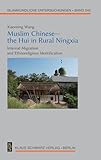Muslim Chinese—the Hui in Rural Ningxia : Internal Migration and Ethnoreligious Identification / Xiaoming Wang.
Material type: TextSeries: Islamkundliche Untersuchungen ; 340Publisher: Berlin ; Boston : De Gruyter, [2020]Copyright date: ©2020Description: 1 online resource (220 p.)Content type:
TextSeries: Islamkundliche Untersuchungen ; 340Publisher: Berlin ; Boston : De Gruyter, [2020]Copyright date: ©2020Description: 1 online resource (220 p.)Content type: - 9783879974931
- 9783112209486
- 305.89510088297 23//gereng
- online - DeGruyter
- Issued also in print.
| Item type | Current library | Call number | URL | Status | Notes | Barcode | |
|---|---|---|---|---|---|---|---|
 eBook
eBook
|
Biblioteca "Angelicum" Pont. Univ. S.Tommaso d'Aquino Nuvola online | online - DeGruyter (Browse shelf(Opens below)) | Online access | Not for loan (Accesso limitato) | Accesso per gli utenti autorizzati / Access for authorized users | (dgr)9783112209486 |
Frontmatter -- Table of Contents -- List of Figures -- Acknowledgements -- Prologue -- Chapter 1. Introduction -- Chapter 2. Who are the Hui: a historical review -- Chapter 3. Ecological and labour migration in rural Ningxia -- Chapter 4. Qingzhen and its changing values -- Chapter 5. Fasting and Ramadan in an immigration area -- Chapter 6. Perspectives on death and the afterlife -- Chapter 7. Social and religious position of migrant women -- Chapter 8. Conclusions -- Glossary -- Bibliography
restricted access online access with authorization star
http://purl.org/coar/access_right/c_16ec
The Hui are predominantly Muslim Chinese who claim ancestry from Persian and Arabicspeaking regions in Central Asia and the Middle East. According to the 2010 census, the Hui are the largest Muslim group in China and its third largest ethnic minority with a total population of 10.6 million. Due to their extensive geographic distribution and longterm acculturation by the atheist Han majority, the question of Hui identity is rarely raised in humanities and social sciences both in China and abroad. This book examines Hui identity in the rural area of Ningxia Hui Autonomous Region, while taking account of China’s rapid modernisation and industrialisation in the twentyfirst century. Specifically, it focuses on the massive internal migration of rural populations, which has been playing an essential role in the socioeconomic life of Chinese peasants in the past few decades. Based on field data collected between 2011 and 2013 among the Jahriyya Hui, the study seeks to clarify the impacts of migration on the Hui’s ethnoreligious identity by investigating three key issues: the Hui’s purity concept, fasting and their belief in the afterworld. In relation to these reference points, religious rituals, including commemoration ceremonies and the Ramadan fast as well as their changing forms and values, are illustrated and analysed. The thesis shows that Islam continues to play a crucial part in drawing boundaries and maintaining identity for the Hui both before and after migration. However, population movements in Ningxia are resulting in increased interactions between Hui and Han populations as well as between Hui from diverse ›menhuan‹ (Sufi paths). Consequently, the Hui’s unique ›menhuan‹ awareness is being weakened and their purity concept subjected to many queries, doubts, ambiguities, and tensions.
Issued also in print.
Mode of access: Internet via World Wide Web.
In English.
Description based on online resource; title from PDF title page (publisher's Web site, viewed 28. Feb 2023)


